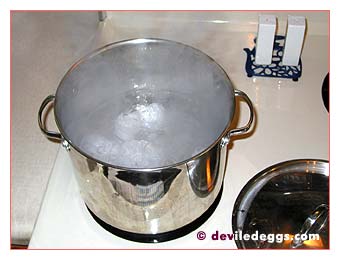Step 2 - Cooking Your Eggs - How to Hard Boil
Next, cover the pot with a tight fitting lid, set your pot
on the stove and turn the burner to high. If your stove burners
are especially hot or if you have a gas stove, you may want
to keep the temperature just a notch from the highest setting
so that the eggs don't bump and jostle around as much while
the water heats up. Every time the eggs collide with each
other increases the chances of one of the eggs cracking. Plan
for about 6 minutes to bring the pot to boiling. Check progress
often, and remember you should never leave pots unattended
on the stove.
 You
need to watch the pot carefully when it is close to the boiling
point. See the picture above? As soon as you get big bubbles
and steam, take the pot off of the burner and move it to a
burner that's turned off. Be careful and use oven gloves since
the pan is very hot. You don't need to boil the water hard
to get those eggs cooked. If you allow the eggs to churn around
in a pot of boiling water for several minutes, this toughens
the egg white considerably, making the white hard and rubbery.
Egg white solidifies between 140º F and 149º F,
and the yolk coagulates between 149º F and 157º
F, much less than the boiling point of water (212º F).
So, the trick is to let the water come to a full boil, then
take the pot off of the burner at that moment. You
need to watch the pot carefully when it is close to the boiling
point. See the picture above? As soon as you get big bubbles
and steam, take the pot off of the burner and move it to a
burner that's turned off. Be careful and use oven gloves since
the pan is very hot. You don't need to boil the water hard
to get those eggs cooked. If you allow the eggs to churn around
in a pot of boiling water for several minutes, this toughens
the egg white considerably, making the white hard and rubbery.
Egg white solidifies between 140º F and 149º F,
and the yolk coagulates between 149º F and 157º
F, much less than the boiling point of water (212º F).
So, the trick is to let the water come to a full boil, then
take the pot off of the burner at that moment.
After you have moved the pot, add 1 tablespoon of vinegar
over the water and eggs. (This will help make your eggs easier
to peel.) No stirring is necessary.
 Here
in this picture, I have taken the pot off of the burner used
for cooking, covered the pot back up, and moved it over to
a spot where the eggs can sit in the hot water for 30 minutes
to finish cooking. Make yourself a nice cup of tea and set
the timer on your stove to remind you to come back for the
next step or else you may do what I have done on occasion
- forgotten about the pot for a couple of hours while I got
busy with a phone call or chores. If this happens, the eggs
will be a bit tougher but are still edible, and you can still
move on to peeling them. Here
in this picture, I have taken the pot off of the burner used
for cooking, covered the pot back up, and moved it over to
a spot where the eggs can sit in the hot water for 30 minutes
to finish cooking. Make yourself a nice cup of tea and set
the timer on your stove to remind you to come back for the
next step or else you may do what I have done on occasion
- forgotten about the pot for a couple of hours while I got
busy with a phone call or chores. If this happens, the eggs
will be a bit tougher but are still edible, and you can still
move on to peeling them.
 So, thirty minutes have gone by already? On
to cooling and peeling .....
So, thirty minutes have gone by already? On
to cooling and peeling .....
|





 You
need to watch the pot carefully when it is close to the boiling
point. See the picture above? As soon as you get big bubbles
and steam, take the pot off of the burner and move it to a
burner that's turned off. Be careful and use oven gloves since
the pan is very hot. You don't need to boil the water hard
to get those eggs cooked. If you allow the eggs to churn around
in a pot of boiling water for several minutes, this toughens
the egg white considerably, making the white hard and rubbery.
Egg white solidifies between 140º F and 149º F,
and the yolk coagulates between 149º F and 157º
F, much less than the boiling point of water (212º F).
So, the trick is to let the water come to a full boil, then
take the pot off of the burner at that moment.
You
need to watch the pot carefully when it is close to the boiling
point. See the picture above? As soon as you get big bubbles
and steam, take the pot off of the burner and move it to a
burner that's turned off. Be careful and use oven gloves since
the pan is very hot. You don't need to boil the water hard
to get those eggs cooked. If you allow the eggs to churn around
in a pot of boiling water for several minutes, this toughens
the egg white considerably, making the white hard and rubbery.
Egg white solidifies between 140º F and 149º F,
and the yolk coagulates between 149º F and 157º
F, much less than the boiling point of water (212º F).
So, the trick is to let the water come to a full boil, then
take the pot off of the burner at that moment.  Here
in this picture, I have taken the pot off of the burner used
for cooking, covered the pot back up, and moved it over to
a spot where the eggs can sit in the hot water for 30 minutes
to finish cooking. Make yourself a nice cup of tea and set
the timer on your stove to remind you to come back for the
next step or else you may do what I have done on occasion
- forgotten about the pot for a couple of hours while I got
busy with a phone call or chores. If this happens, the eggs
will be a bit tougher but are still edible, and you can still
move on to peeling them.
Here
in this picture, I have taken the pot off of the burner used
for cooking, covered the pot back up, and moved it over to
a spot where the eggs can sit in the hot water for 30 minutes
to finish cooking. Make yourself a nice cup of tea and set
the timer on your stove to remind you to come back for the
next step or else you may do what I have done on occasion
- forgotten about the pot for a couple of hours while I got
busy with a phone call or chores. If this happens, the eggs
will be a bit tougher but are still edible, and you can still
move on to peeling them.